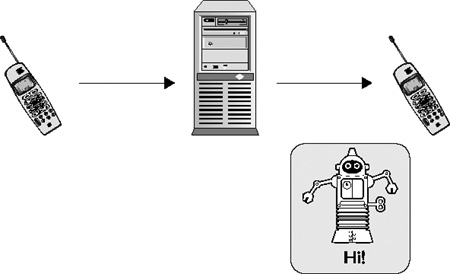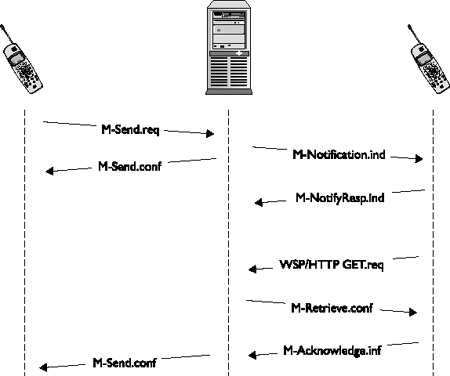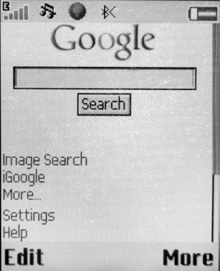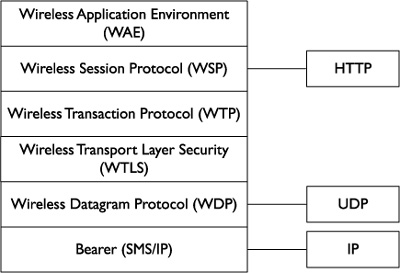When SMS was first designed, it was only to send
basic text content of a relatively small size. As with many
technologies, however, it has since progressed far beyond its original
design goals. Multimedia Messaging Service (MMS) is the next progression
in the usage of SMS. MMS can send various types of images, audio, and
video in addition to text. The demand for this functionality arose out
of the changing nature of mobile phones themselves. As time progressed,
mobile phones began to contain more and more functionality, such as the
ability to record audio, take pictures, and even record video. Once
users had this technology in their phones, carriers saw the potential to
generate new streams of revenue by allowing users to share their audio
and video content with each other, hence the creation of MMS.
Initially from an
introductory high level, MMS can be thought of as fairly similar to SMS.
For example, consider the typical use case of MMS as shown in Figure 1.
In this example, Bob wants to send a picture of his new robot to Alice.
Unlike with SMS however, Alice receives a message notification rather
than message content. Alice selects to download the message contents to
her phone from the carrier’s servers. Upon successful download, the
image and text is displayed to Alice.

Although it may appear to the
user that MMS is almost exactly like SMS, MMS is fundamentally different
from SMS. From the mobile carrier perspective, MMS requires a far
higher level of equipment and support. This is illustrated in Figure 2,
which shows the delivery of an MMS message with more details provided.
In another example of its additional complexity over SMS, MMS does not
use just one technology. Rather, several technologies are used
throughout the creation and delivery of an MMS message.

For
these reasons, not all carriers implement full support for MMS. As
discussed, true MMS support should allow users to be able to send any
audio, video, or pictures of their choice. However, carriers will often
limit the functionality allowed on their networks to simple pictures.
Finally, some carriers do not even truly support MMS but instead fake it
by embedding a link to MMS content within a normal SMS. The user then
visits the carrier’s website using the cell phone’s web browser.
|
WAP is a collection of
standards developed in order to provide Internet access to cell phones.
The standards were originally written by the WAP Forum and later by the
Open Mobile Alliance (OMA). Both of the groups’ memberships include
equipment vendors.
WAP is used primarily to
provide interactive content such as web browsing as well as to provide
carrier-specific information to phones in the background. Figure 3 shows a phone accessing a WAP site.

WAP browsers use Wireless
Markup Language (WML) rather than HTML. There are many similarities
between the WAP protocol suite or stack and common IP protocols; Figure 4 illustrates some of these similarities. Keep in mind that these are not exactly the same but rather close equivalents.

The lowest level on the WAP stack from Figure 4 is described as bearer,
which is a protocol that can carry Wireless Datagram Protocol (WDP).
The most common bearers are SMS- and IP-based ones.
WDP is designed to be very
similar to User Datagram Protocol (UDP). Traffic is expensive over
cellular networks—not only in data costs, but transmission costs are
also high. Battery life is a crucial resource, and as such a UDP-like
protocol eliminates the overhead associated with TCP.
Wireless Session Protocol
(WSP) is equivalent to HTTP, in particular HTTP/1.1. However, in order
to save space, the protocol is binary. In essence, WSP is a compressed
form of HTTP.
Wireless
Application Environment (WAE) carries various markup languages. Older
implementations (WAP 1.x) use WML. Newer implementations (WAP 2.0) use
XHTML-MP. These markup languages are similar to various nonmobile markup
languages for web content.
|